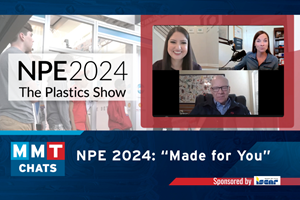Keeping Up with ISO: Meeting Objectives
The updated standard defines new objectives to ensure ongoing quality.
Successful moldmakers and molders know their customers’ needs from design and prototyping to production and finishing. They fulfill customer requirements because they control their processes and ensure quality in the long term by using a quality management system such as ISO 9001:2015.
Basically, ISO 9001:2015 reveals ways to report manufacturing efficiencies and cost controls to help the bottom line. For example, OEMs are looking for suppliers that are vertically integrated and have value-added operations. Mold builders and molders must develop a value-chain relationship with customers and suppliers to improve the OEM’s total cost of ownership with their cost-saving technologies. Supplier cost controls for tooling and mold building include metals, EDM, CNC milling, CAD, CAE and CAM; and control costs for injection molding include materials (resins and compounds) and assembly costs.
A challenge for moldmakers and molders is surpassing their current levels of quality despite the fact that one person may now be doing the job of three. This is where ISO 9001 certi-fication comes into play, especially for smaller companies. Certification helps control the quality and effectiveness of management systems, and reduce costs associated with poor quality. This can be accomplished by reducing scrap and waste, and increasing awareness of customer requirements using corrective and preventive actions. Companies seek certification for a variety of reasons, including that customers demand it, because the competition is certified, to grow market share or to sell overseas. Whatever the motivation to seek certification, a company should entrust that task to an industry-specific ISO specialist.
Getting Started
ISO 9001:2015 defines new objectives to ensure ongoing quality. The objectives in ISO 9001:2008 were only in manufacturing. Now, supplier control and customer development objectives must also be included to support and improve the financial objectives. These include: partnering with manufacturers in mutually beneficial relationships; building loyalty with clients through superior service and quality; maintaining relationships through consistency and continuous improvement; and creating a motivating, healthy and sustainable environment for your team.
The first step to meeting these objectives is to assess what you really know about your company. To do that, try answering these questions: What are company sales? Is company growth increasing, flat or declining? What is the company’s profit margin? Is it growing, flat or declining? How does your margin compare with those of the competition? What is your inventory velocity? Your asset velocity? What is your return on assets? Is your cash generation increasing or decreasing? How do you control your suppliers? How do you communicate with existing customers and potential customers? How are you addressing and preparing for the millennial skills gap? Is your company gaining or losing against the competition?
ISO 9001:2015 helps to capture these insights with advanced quality planning that provides a clear understanding of the basic building blocks of a business, which include identifying ways your company makes money and operates as a total business (eliminating waste and lowering costs), and establishing methods for moving forward despite the clutter of day-to-day business and real-world complexities.
Next are the upgrade assessments and audits performed by industry-specific ISO specialists/auditors. ISO 9001:2008 required these to be completed in only one stage. The latest revision requires completion in two stages in order to be more effective and efficient.
Stage 1 is a first-party assessment/audit (internal training and self-compliance) that ensures full deployment of the new ISO requirements before the Stage 2 audit. This stage must be conducted
two to three months prior to Stage 2. Areas reviewed during Stage 1 include: identification of interested parties and their requirements; identification of risks and opportunities; identification of processes; context of the organization and leadership requirements; review of one round of process-based internal audits; at least one management review; an understanding of the requirements; and deployment of a process-based management system.
Stage 2 is a second-party and/or third-party assessment/audit. Since moldmakers and molders depend on their suppliers to contribute to the success of their own businesses, supplier audits/assessments are a great way to have transparency and can lead to product/service improvement.
Moldmakers and molders must document, develop, maintain and control their suppliers via the selection process and a scorecard. Selection involves ensuring they can supply required materials that meet requirements in customer quality, delivery and price. A supplier quality survey/questionnaire is used here. A scorecard measures a supplier’s ability to provide products and services in terms of its technology, price, quality and delivery for continuous improvement. This two-step process helps to establish a “preferred” supplier list.
By having a set system to track and monitor your suppliers’ compliance, your company can mitigate risk. A typical supplier audit/assessment yields measureable data, process improvements and cost reductions. If a moldmaker/molder does not specify all materials in total detail, there will be problems. You must tightly control all material inventory and obtain certifications every step of the way so that cheaper materials are not substituted. You must audit the certifications and conduct metallurgy tests, resin tests, etc. Material substitution is more common of a problem than you might think.
Process assessments/audits are another component of both Stage 1 and Stage 2. When there is a breakdown in process, a moldmaker or molder can suffer great losses, but it may be difficult for an insider to pinpoint the breakdown. Process assessments/audits help identify the breakdown so it can be fixed. With a process audit, the auditors focus on a specific area instead of reviewing everything. It allows companies to isolate the areas they believe need improvement, such as records on maintenance and calibration on molds and/or injection molding machines that are not up-to-date, instead of the areas that are functioning well.
Two-stage upgrade assessments/audits of your management system gives top management the assurance that the system conforms to the requirements of the standard. The insight gained will help improve and support your decision-making process.
Related Content
The Critical Role of Management Representatives in ISO 9001
In ISO 9001 quality management systems, the Management Representative (MR) plays a crucial role. While the 2015 version of ISO 9001 no longer mandates this position, having a trusted management member serve as an MR remains vital for streamlining operations and maintaining quality standards.
Read MoreCertified Quality Management for Plastics Professionals – Materials to Tooling to Recycling
Why is certification of a shop’s quality management system to ISO 9001, AS9100, IATF 16949 or ISO 13485 so special? What does the certification signify? And what supports the paper behind the framed certificate?
Read MoreMMT Chats: A More Modern NPE “Made for You”
The Plastics Industry Association is making NPE 2024 a “can’t miss”’ experience with more of everything – education, exhibitors and networking! The PLASTICS Industry Association Chief Operating Officer Glenn Anderson and Director of Trade Show Marketing Damaris Piraino share what’s in store for attendees of next year’s May 6-10, 2024 in Orlando, Florida.
Read MoreShift in U.S. Mold Imports: Emerging Countries Gain Ground in Market Share
The dynamic nature of the U.S. mold industry's global trade landscape offers challenges and opportunities for growth.
Read MoreRead Next
Keeping Up with ISO: Moving to ISO 9001:2015 Requires a Top-Down Approach
Implementing ISO guiding principles to govern every activity within a moldmaking or molding facility is essential to properly managing the supply chain. This new column will share knowledge, highlight opportunities and spotlight rewards of the ISO 9001: 2015 revision.
Read MoreHow to Use Strategic Planning Tools, Data to Manage the Human Side of Business
Q&A with Marion Wells, MMT EAB member and founder of Human Asset Management.
Read MoreHow to Use Continuing Education to Remain Competitive in Moldmaking
Continued training helps moldmakers make tooling decisions and properly use the latest cutting tool to efficiently machine high-quality molds.
Read More




















